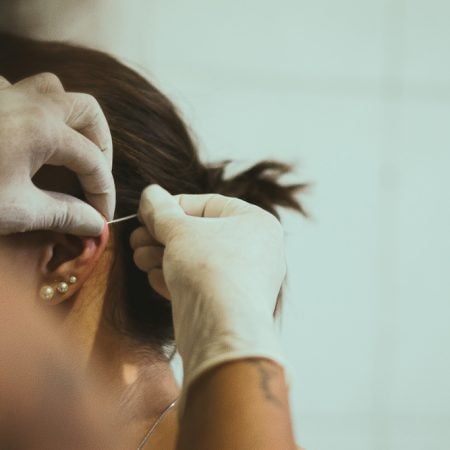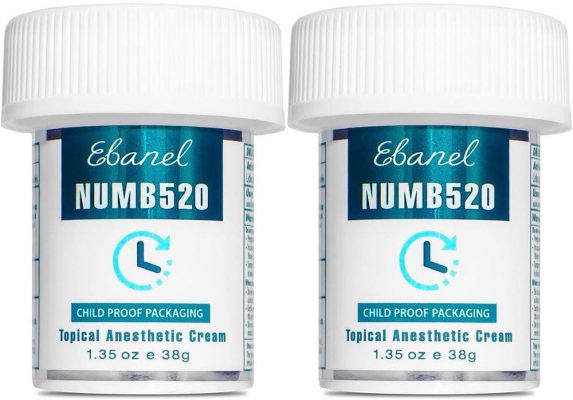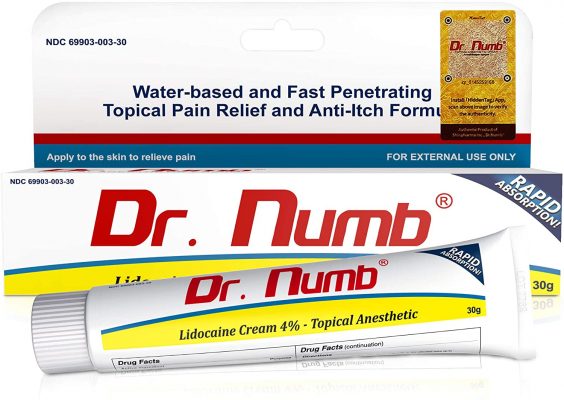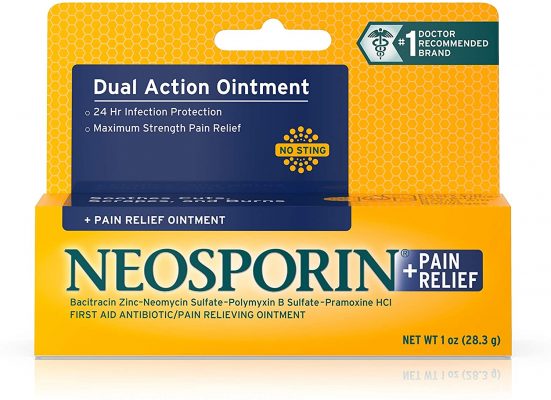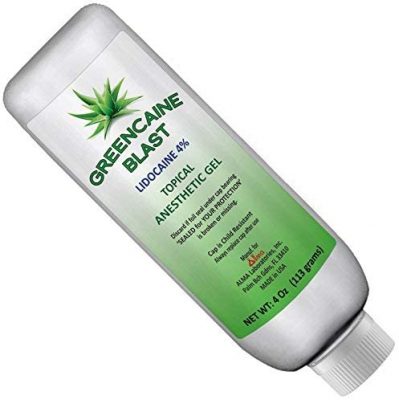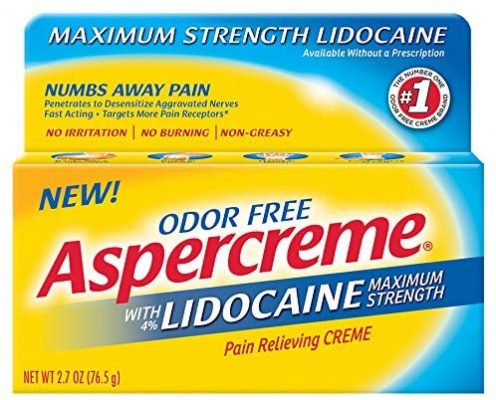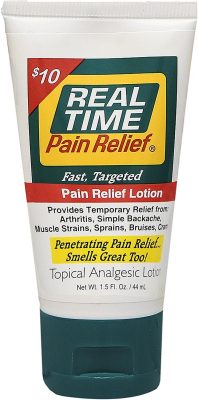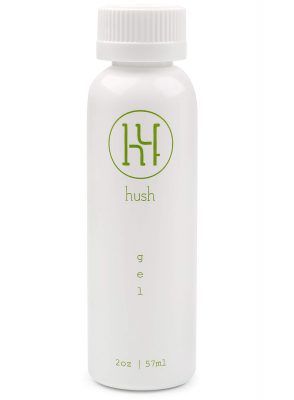If you’re looking to get a piercing, chances are one of your top worries is the pain involved with the process. A piercing may look cool, but is it worth the pain during your appointment and the days after? Luckily, tattoo artists and piercers are well acquainted with both squeamish and “tough guy” clients. If your main concern in getting a piercing is the pain, talk to your artist about numbing creams. Many artists have them at their shops or will allow you to bring your own to your appointment.
- How to Choose the Perfect Piercing Numbing Cream
- Top 10 Best Piercing Numbing Creams 2024
- 1. Best Overall Numbing Cream Ebanel 5% Lidocaine Numbing Cream
- 2. Best Premium Numbing Cream Dr. Numb 4% Lidocaine Numbing Cream
- 3. Best Aftercare Numbing Cream Neosporin Maximum Strength Dual Action
- 4. Best Maximum-Strength Numbing Cream Zensa Maximum Strength Topical Anesthetic
- 5. Greencaine Blast Numbing Cream
- 6. Best Numbing Spray Ebanel 5% Lidocaine Spray
- 7. Best Budget Numbing Cream Aspercreme Pain Relieving Crème with Lidocaine
- 8. Best Medical-Grade Numbing Cream LMX5 Lidocaine Pain Relief Cream
- 9. Best Alternative-Ingredient Numbing Cream Real Time Pain Relief Menthol Cream
- 10. Best Natural Numbing Cream Hush Anesthetic Numbing Gel
- A Complete Guide to Piercing and Pain Relief
- Final Thoughts
How to Choose the Perfect Piercing Numbing Cream
Before we get into our recommendations for the best numbing creams on the market, there are a few things that you should understand so that you’re able to make an informed decision.
Piercing Pain
When you get a piercing, you’re going to experience two types of pain. The first type occurs right when you get the piercing. It is immediate and brief, but sometimes quite strong. Sometimes, people find this pain a part of the experience, but others prefer to avoid the unpleasant part of getting pierces.
The second type of pain is associated with healing and recovery. Your body thinks your new piercing is an injury, so it’s using pain to draw your attention to it. This helps encourage you to keep the site clean, care for the piercing, and avoid infection.
For an in-depth discussion of pain and body piercing, our piercing guide discusses each type of piercing and the pain you can expect.
Anesthetics and Body Piercing
Pain after the fact is hard to dull, but proper care can help reduce pain, and there are pain relief creams that can reduce your discomfort. However, you can easily avoid the immediate pain of getting your piercing by using a localized anesthetic.
If you choose to use an anesthetic to numb the pain, you’ll often end up using a numbing cream. This cream dulls the immediate pain of a piercing. You or your artist will apply the cream prior to your appointment, so that by the time your artist is ready to start, the site of your piercing will be numb. If you’ve ever gotten a cavity filled, your dentist may have used a similar topical anesthetic so you wouldn’t feel the procedure.
@zensaskin Why just get one piercing when you can get multiple at once?#Zensa #Piercings #NumbingCream #Earrings #Piercing #SummerAccessories #PainFree
What’s in a Numbing Cream?
Most numbing creams are made of lidocaine, prilocaine, or tetracaine. These are anesthetics that block signals to the brain wherever they’re applied. By preventing pain messaging from reaching the brain, anesthetics prevent the sensation of pain. Milder numbing creams might use menthol or bacitracin as their active ingredient.
Numbing creams may also contain a variety of other ingredients, such as aloe vera or oils. Depending on whether they’re intended for pre-application or aftercare, they may contain anti-bacterial compounds to prevent infection or moisturizer to promote skin health. To learn more, take a look at our active ingredients section at the end of the article.
Things to Consider When Choosing a Numbing Cream
When deciding what numbing cream to use, your first priority should always be ingredients. If you have an allergy, sensitivity, or you wish to avoid addictive substances, you should check both active and inactive ingredients lists to make sure nothing is going to give you a bad reaction.
For each item on our list, we will highlight its active ingredient, as well as any unusual inactive ingredients that might case issues. If your piercing is in a highly sensitive location, you may want to avoid certain extra ingredients for your own health.
You should also consider whether the cream is intended for immediate pain relief or recovery-related pain relief. Certain creams will be better suited to different stages of pain. We’ll be sure to let you know which cream is best suited for you.
You may also need to consider quality of the cream, including how intense the numbing action is and what kind of certifications it has. A highly-certified cream is more likely to have medical effects, while others may offer mild pain relief, with more of a focus on skin care in the area. We’ll be sure to classify each product as offering mild, moderate, or intense pain relief, and we’ll make a note of which agencies have approved it for use.
Now that you’ve gotten an idea of what you’re looking for, let’s jump in to our top ten list of piercing numbing creams!

Top 10 Best Piercing Numbing Creams 2024
1. Best Overall Numbing Cream Ebanel 5% Lidocaine Numbing Cream
Editor’s Rating:
At a Glance
Active Ingredient: 5% Lidocaine
Intended Use: Pre-procedure
Pain Relief: Intense
This piercing numbing cream fully numbs the area to which it is applied. It includes liposomal in its ingredients, allowing it to provide numbing below the surface, unlike many other surface-only numbing creams. This makes it ideal for piercings with deep channels. In other ingredients, this numbing cream lists aloe vera, vitamin E, lecithin, and allantoin to hydrate the skin.
Standards
Ebanel 5% Lidocaine Numbing Cream is FDA compliant and certified according to the FDA’s current Good Manufacturing Practices standards.
Application
This cream is oil-free to prevent the piercing needle from slipping during the procedure, but you will need to use gloves to keep the cream from affecting your hands. It can be somewhat expensive, and you may need to use a full container for one piercing. However, it is the most consistently effective cream offered by online retailers. This numbing cream should be applied 15 to 30 minutes before your piercing for maximum numbness, and lasts for approximately two hours.
Pros
- Consistently effective
- Long lasting
- Liposomal allows pain relief to go below the surface
- Oil-free to prevent needle slips
- cGMP certified
Cons
- Each tube doesn’t contain much cream
Editor’s Rating:
At a Glance
Active Ingredient: 4% Lidocaine
Intended Use: Pre-procedure
Pain Relief: Intense
Dr. Numb is one of the most superior numbing creams on the market. It may be expensive, but its double-layer method increases the potency of the lidocaine. Its fast-acting absorption makes it ideal for anyone looking to numb the pain of a piercing. Dr. Numb offers this 4% cream, designed specifically for piercings and tattoos, however, if you’re looking for stronger relief, Dr. Numb also offers a 5% lidocaine option.
Standards
Dr. Numb is FDA and cGMP compliant and is authorized for over the counter sale in Australia, Canada, and the US. Piercing parlors recommend it, and home-piercers swear by it.
Application
This cream absorbs quickly and has one of the longest numbing windows on the market, advertised at between two and four hours for long-lasting relief. Its water-based solution offers quicker absorption and a more intense transfer of lidocaine. It may not be the best choice for anyone sitting for a tattoo, though, as it is most effective when applied over a small area.
Pros
- Offers 4% and 5% options
- Super effective for piercing pain
- Approved for sale in Canada and Australia
- Great reputation for pain relief
Cons
- Requires double-layer application
- Most effective over a small area
3. Best Aftercare Numbing Cream Neosporin Maximum Strength Dual Action
Editor’s Rating:
At a Glance
Active Ingredient: Bacitracin, neomycin, and polymyxin B
Intended Use: Post-procedure care
Pain Relief: Moderate
There’s a reason that moms everywhere swear by Neosporin for scrapes, cuts, and worse. Neosporin offers pain relief and aftercare for shallow to moderately deep wounds, making it perfect for piercings. Its primary ingredient, bacitracin, is an antibiotic which helps prevent infection and scarring. It’s not quite as fast-acting and many other pain relief creams. Instead of numbing the site of the piercing, Neosporin provides after-the-fact pain relief to ease discomfort associated with recovery and healing at the site.
Standards
Neosporin is the #1 doctor recommended wound care ointment. Where many OTC creams are only compliant with FDA standards, Neosporin is FDA approved.
Application
The most attractive feature of Neosporin is that it’s rated for application on broken skin. If your piercing is still open, you won’t suffer ill effects from applying this cream. After the numbing wears off, you can apply this cream one to three times per day for maximum pain relief and infection prevention.
Pros
- Infection prevention
- Recovery pain relief
- Great budget option
- Highly trusted by doctors and consumers
- FDA-approved
Cons
- Only offers moderate, post-piercing relief
4. Best Maximum-Strength Numbing Cream Zensa Maximum Strength Topical Anesthetic
Editor’s Rating:
At a Glance
Active Ingredient: 5% lidocaine
Intended Use: Pre-procedure
Pain Relief: Intense
Zensa may be more expensive, but it is ideal for extremely painful piercing sites. If you plan to get a piercing in a highly sensitive location, Zensa is a great option for serious pain prevention. It doesn’t last as long as other creams, but it is far more potent than many other creams. Unfortunately, if you intend to cover a large area, you will need to use most of the tube. Zensa uses vitamin E as its anti-inflammatory ingredient.
Standards
Zensa Maximum Strength Topical Anesthetic is Health Canada certified and FDA compliant. It is also vegan-friendly and steroid-free. Steroids are anti-inflammatories, but if you are sensitive to steroids, they may cause a harmful allergic reaction.
Application
Unlike other numbing creams, Zensa, like Neosporin is rated for use on broken skin, meaning it can be used even after the piercing to provide numbing with no fear of adverse reaction at the site. Zensa should be applied 30 to 45 minutes prior to the procedure and lasts approximately 90 minutes after peak absorption.
Pros
- Maximum strength
- Steroid-free
- Vegan
- Rated for post-procedure pain relief
Cons
- More expensive than other options
- Pain relief is not as long-lasting
5. Greencaine Blast Numbing Cream
Editor’s Rating:
At a Glance
Active Ingredient: 4% lidocaine
Intended Use: Pre-procedure
Pain Relief: Moderate
Greencaine Blast is one of the more cost-effective pre-procedure numbing options. For a piercing, which only takes a moment, it is definitely effective. Beauticians conducting treatments with related pain, like waxing, micro-blading, and injections, have had great success using Greencaine to dull and eliminate client pain.
Standards
Greencaine is FDA compliant.
Application
Greencaine does not need to be wrapped to be effective, but saran-wrapping the site can extend its effects and intensify the pain relief. It contains aloe vera to soothe irritation, making it ideal for sensitive areas. It does not last as long as many tattoo-rated numbing creams, with an average window of just over an hour.
Pros
- Cost-effective
- Great for painful beauty treatments
- Aloe vera soothes irritation
Cons
- Pain relief is not as powerful
6. Best Numbing Spray Ebanel 5% Lidocaine Spray
Editor’s Rating:
At aGlance
Active Ingredient: 5% lidocaine, 0.25% phenylephrine
Intended Use: Pre- and post-procedure
Pain Relief: Moderate
This spray is ideal for use on already sensitive areas or areas that may be hard to reach and cover. Ebanel 5% Lidocaine Spray is fast-acting, taking effect within minutes. It offers a piercing numbing experience with less hassle. If you plan to get a piercing in a textured area, this spray can help achieve proper coverage, even in hard to reach areas. However, you should not use this spray on your face, as the risk of it getting into your eyes or mouth is much higher with a spray than a cream.
Standards
Ebanel 5% Lidocaine Spray is FDA compliant.
Application
As a spray on anesthetic, it is ideal for areas you don’t want to touch, and eliminates the need for gloves and area clean up after application. If you’re in a time crunch and don’t have time to apply numbing cream at home, Ebanel 5% Lidocaine Spray allows you to apply the anesthetic closer to your appointment and without the mess of creams or gels.
When using, you can spray once for moderate pain relief, or reapply five minutes after the first coat for enhanced pain relief. This spray is designed for a short window of use. It sets in within five to ten minutes, peaks at fifteen minutes, and lasts approximately an hour.
Pros
- Spray version offers easy application
- No-touch application is ideal for sore skin
- Extremely fast acting compared to other numbing products
- No gloves required and less clean-up after application
Cons
- Shorter window of effectiveness
- Should not be used on the face
7. Best Budget Numbing Cream Aspercreme Pain Relieving Crème with Lidocaine
Editor’s Rating:
At a Glance
Active Ingredient: 4% Lidocaine
Intended Use: Pre- and Post-procedure
Pain Relief: Mild
Our budget-friendly option is ideal for anyone looking to reduce pain after their procedure. You may want to use a more powerful numbing cream for the procedure itself, and rely on a mild, less expensive pain relief cream for post-procedure care. Aspercreme Pain Relieving Crème with Lidocaine can be used to reduce the pain of the procedure, but it doesn’t have the same effects as more potent numbing cream. You will likely still feel the needle, but pain associated with it will be reduced.
Standards
Aspercreme Pain Relieving Crème with Lidocaine does not advertise itself as FDA compliant. It is salicylate-free, making it ideal for those with salicylate sensitivities.
Application
Aspercreme can offer some pain reduction if used prior to the procedure, however it is best suited as post-piercing pain relief. It will not numb the area, merely reduce pain. It is odor-free and ideal for addressing low-level constant pain, rather than sharp, intermittent pain. It begins working quickly and offers up to three hours of pain relief.
Pros
- Great budget choice
- Good for aftercare pain relief
- Odorless
- Reduces pain over a long period of time
Cons
- Does not numb the area
- Not advertised as FDA compliant
8. Best Medical-Grade Numbing Cream LMX5 Lidocaine Pain Relief Cream
Editor’s Rating:
At a Glance
Active Ingredient: 5% lidocaine
Intended Use: Pre-procedure
Pain Relief: Intense
LMX5 Lidocaine Pain Relief Cream is a powerful, medical-grade numbing cream. It is highly expensive, however, and may be overly potent for simple piercings. If you intend to pierce a highly sensitive area, this cream almost entirely eliminates feeling in the area. This cream is neck and neck with Zensa Anesthetic and Dr. Numb in terms of potency.
Standards
LMX5 is FDA compliant and recommended by the Baylor College of Medicine’s Department of Dermatology.
Application
If you intend to have multiple piercings done in one session, LMX5 Lidocaine Pain Relief Cream is a good option, but for the average piercing it could be considered overkill. Because it is so strong, it carries a risk of overdose when applied to large areas. It takes approximately 30 minutes to begin numbing the area, peaks at one hour to 90 minutes, and lasts for two to three hours.
Pros
- Offers intense pain relief
- Near total numbing
- Recommended by Baylor College of Medicine
- Long-lasting effects
Cons
- May be too intense for regular piercings
- Expensive
9. Best Alternative-Ingredient Numbing Cream Real Time Pain Relief Menthol Cream
Editor’s Rating:
At a Glance
Active Ingredient: Menthol
Intended Use: Post-procedure
Pain Relief: Mild
Real Time Pain Relief Menthol Cream is a great alternative for anyone looking to relieve pain without the help of lidocaine or bacitracin. Menthol is a trusted pain remedy for muscle and surface pain. This cream also contains a variety of natural pain soothing ingredients, including capsicum, aloe vera, glucosamine, emu oil, witch hazel, willow bark, German chamomile, coriander fruit oil, tilia cordata, arnica, chondroitin, methylsulfonylmethane (MSM), calendula, St. John’s wort, Roman chamomile, and centaurea cyanus. These supplements are naturally derived and can help ease swelling and circulation woes and reduce pain. If you’re looking for a more natural pain reliever, this cream offers an abundance of natural extracts.
Standards
Real Time Pain Relief is FDA compliant and manufactured in a plant monitored by the FDA. This cream is also free of parabens, NSAIDs, and acetaminophen.
Application
Real Time Pain Relief is quick-acting and ideal for dull pain relief. It can be applied as needed, with no worries of an overdose, as its primary ingredient, menthol, is rarely harmful. It is odorless, despite being menthol-based, and is effective in minutes. It should not be used pre-procedure, as it is not designed to anesthetize the piercing site, but it can reduce the pain of a piercing in recovery.
Pros
- Budget friendly
- NSAID and Acetaminophen-free
- Contains many natural extracts
- Menthol-based
Cons
- Offers only mild pain relief
10. Best Natural Numbing Cream Hush Anesthetic Numbing Gel
Editor’s Rating:
At a Glance
Active Ingredient: 4% lidocaine
Intended Use: Pre-procedure
Pain Relief: Intense
While not as powerful as our premium pick and not quite as consistent as our overall best pick, the Hush anesthetic is tattoo-strength and trusted by tattoo artists for helping numb sensitive areas.
Many other numbing creams contain epinephrine to reduce swelling, but Hush relies on botanicals like aloe, calendula, chamomile, and menthol. While this may seem like a downside of the product, it allows anyone with epinephrine sensitivity to use Hush Numbing Gel for their piercing procedure.
Standards
Hush Anesthetic Numbing Gel is FDA compliant, cruelty-free and vegan. It is also epinephrine-free.
Application
Hush should be applied one hour before your appointment and saran-wrapped for maximum numbing action. Hush is unique in that it offers a line of body products designed to help minimize swelling and extend pain relief. It offers a spray that you can put on while the area is sensitive to the touch to further relieve pain, and several other cleansing products that may help with recovery.
Pros
- Vegan and cruelty-free
- Epinephrine-free
- Offers a line of related products
- Great for already sensitive areas
- Gel base may be more comfortable than cream base
Cons
- Not quite as powerful as other numbing creams
A Complete Guide to Piercing and Pain Relief
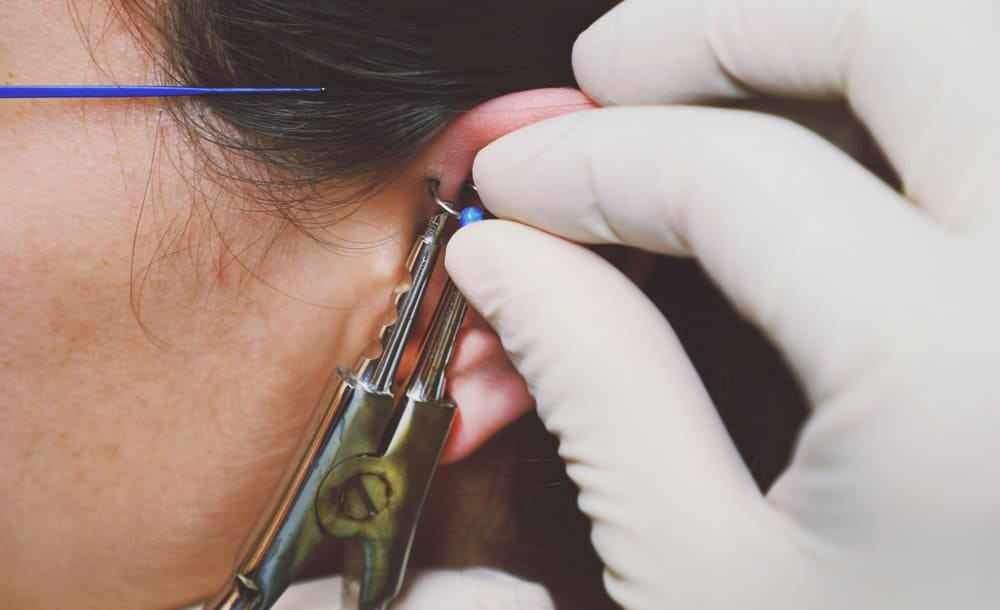
When you decide to get a piercing, your artist may recommend a numbing cream to you, but sometimes they leave you in the dark. You might be wondering how much pain to expect, what creams are best, and whether your pain tolerance is too low to get pierced without anesthetic.
When you get a piercing, it’s important to be as knowledgeable as you can. You may have heard tales of little kids piercing their own ears while away at camp, but anyone who’s tried a home piercing knows that things can easily go wrong.
A piercing, and any body art, is a commitment. You should be prepared to care for it both during the initial healing stage and for as long as you have it.
What to Expect
Almost every type of piercing will have some pain associated with it, but the intensity of the pain, the chances of infection varies depending on the type of piercing and where you go.
Ear Piercing
@anamar_piercings 😲 Pain Free Piercings!!! #numbingcream #skinpreptips #numb #tiktokviral #ouchie #mbtattoostudio #anamarpiercings #piercinglovers
We’ll start simple, with ear piercings. Piercing your ears in the lobe is one of the least painful types of piercings. The fatty lobe isn’t terrible sensitive, and the softness means that it will provide minimal resistance. Ear piercings heal fairly quickly, as well, meaning they’re less likely to get infected. Unusual ear piercings, like conch piercings or daith piercings, are typically more painful, but they’re still low on the pain scale. Unless you are terrible anxious or you are a parent seeking to pierce your infant’s ears, you shouldn’t need to use numbing cream—though something mild like Aspercreme couldn’t hurt.
Bellybutton Piercing
Piercing your bellybutton is slightly more painful than ear-piercing, and taking care of a bellybutton piercing can be difficult. However, belly buttons are essentially made of scar tissue, so they are less nerve dense than other areas.
Tongue Piercing
Tongue piercings are surprisingly low on the pain scale, but they can be incredible difficult to take care of. The mouth is full of bacteria that can infect a piercing, and it is easy to damage or delay healing by messing with your piercing. Numbing creams are for external use only, so you should not use any of the products on our list to prepare for a tongue piercing. You may be able to use Chloraseptic Throat Spray or ice as a numbing agent.
Eyebrow Piercing
Eyebrow piercing pain is right on the edge of being truly painful. Depending on the location of the piercing, the pain can be stronger or weaker. The further towards the center of the forehead the piercing is, the more painful it will be. If you have a low pain tolerance, you may find a numbing cream like the Ebanel 5% Lidocaine Numbing Cream helpful.
Lip Piercing
Our lips are highly sensitive, so a lip piercing has the potential to be quite painful. Placement is a highly personal choice, as is the type of piercing. If you’re worried about pain, you may be able to decrease it with numbing cream on the outer site.
Dermal Piercing
A dermal piercing is any piercing that goes into the skin without coming out the other side. Dimple piercing, back piercing, collar piercing—all of these piercings are going to come with some pain. The more sensitive the area, the more likely you are to want numbing cream—and if you’re particularly sensitive to pain, you might want something strong like the LMX5 Lidocaine Pain Relief Cream.
Nose Piercing
Nose piercing pain varies depending on where you choose to get the piercing. A septum piercing pierces the skin between your two nostrils. It may hurt a lot, but it should heal more quickly. Piercing your nostril will hurt less, but it will take longer to heal.
Nipple Piercing
Nipple piercing is up there as one of the most painful types of piercings. As an erogenous zone, it tends to send more intense signals to the brain. For women, nipple piercing pain can increase or decrease depending on your cycle and your sensitivity. Many people opt to use intense numbing cream to avoid the pain of this piercing. A more intense cream, like Dr. Numb or Zensa Maximum Strength, is a good choice for this type of piercing.
Genital Piercing
As can be expected, genital piercing is generally the most painful type of piercing. Genital piercings are usually placed in erogenous zones, meaning that they will be highly sensitive, and the different types of piercings in this region may vary in terms of pain. If you are sensitive to pain, you will almost definitely want a strong numbing cream. In this case, even the LMX5 Lidocaine Cream may struggle to fully dull the pain.
Of course, many people going for a more unusual piercing do so as a daring move. The pain of body piercing is seen as a rite of passage, or as a small price to pay for the adrenaline rush associated with it. Whether you decide to use a numbing cream or not, it is important to remember that your comfort is most important. Don’t give in to pressures not to use a numbing cream if you feel certain that you don’t want to experience the pain involved with body piercing.
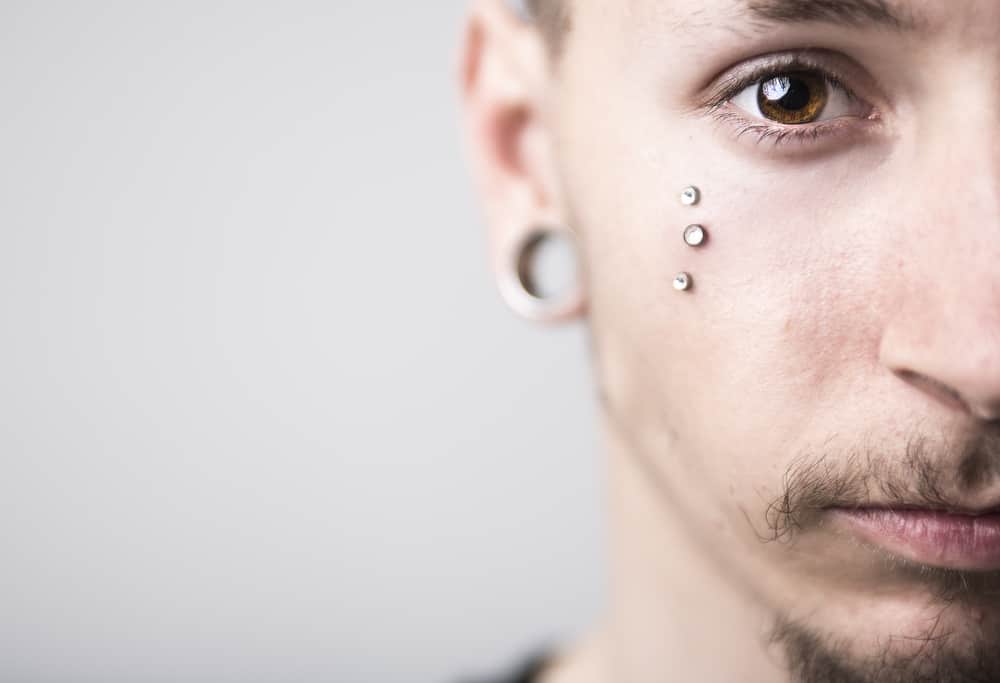
Choosing the Right Pain Relief for You
The market for pain relief can be confusing if you’re not used to reading through ingredients labels and medical jargon. Looking through comments and reviews can leave you feeling less sure than ever. Glowing reviews are side by side with angry ones, but it’s hard to know whether the poor reviews are due to the product not working or to the reviewer using it incorrectly. The simplest way to decide on numbing ointment is to look first at the active ingredients, identify safety concerns and reputability, and lastly decide what you’re willing to pay for your ointment.
Active Ingredients
There are a wide variety of numbing and pain-killing drugs. From lidocaine to menthol to paracetamol, how strong they are and how local the effects are can vary dramatically. For localized anesthetics, lidocaine is generally the most effective at decreasing pain. It may be used by doctors, dentists, and surgeons for minor procedures. Unfortunately, like any drug, lidocaine can have unpleasant side effects if it mixes with other drugs.
Bacitracin, neomycin, and polymyxin B together offer pain relief and anti-infection support for wound care. Medications with these active ingredients act as great all-purpose pain relievers and aftercare options, but they don’t provide anesthetic effects.
Menthol and other mild pain relievers don’t provide anesthetic numbing, but they can help after the procedure. Menthol works by providing alternating warm and cool sensations on the skin. This is intended to distract from the pain, max out the nerves, and cause desensitization in the area.
Other ingredients, like steroids, aloe vera, botanical extracts, and vitamin E may also be included to prevent inflammation and swelling or soothe the skin.
Safety Concerns
When you’re picking out a medication, especially a medication from online retailers, you may be worried about safety. Unfortunately, the FDA doesn’t regulate over the counter medications as stringently as you might expect. They approve drugs and active ingredients, but not necessarily specific products. Instead, they use something called the current Good Manufacturing Practices to regulate drug production.
However, there are cases in which the FDA might specifically approve certain combinations. In our list Neosporin is approved by the FDA. Zensa Maximum Strength claims to be approved by the FDA, but, like other products in our list, it isn’t specifically approved, merely FDA compliant.
Our Best Budget Piercing Numbing Cream makes no mention of FDA compliance, but the Aspercreme company and this creams active ingredient, lidocaine, are FDA compliant.
If you want to check a specific drug for safety, the FDA has a searchable database of safety information for each drug.
Other Concerns
No doubt, when choosing your cream, you may have specific concerns unrelated to the quality of the pain relief. For vegans, there are two great numbing cream options: Hush Numbing Gel and Zensa Maximum Strength Topical Anesthetic. Both of these products are guaranteed vegan-friendly and cruelty-free.
If you wish to avoid specific ingredients, Real Time Pain Relief is NSAID and acetaminophen-free, Hush Numbing Gel is epinephrine-free, Aspercreme is salicylate-free, and Zensa Maximum Strength Topical Anesthetic is steroid-free.
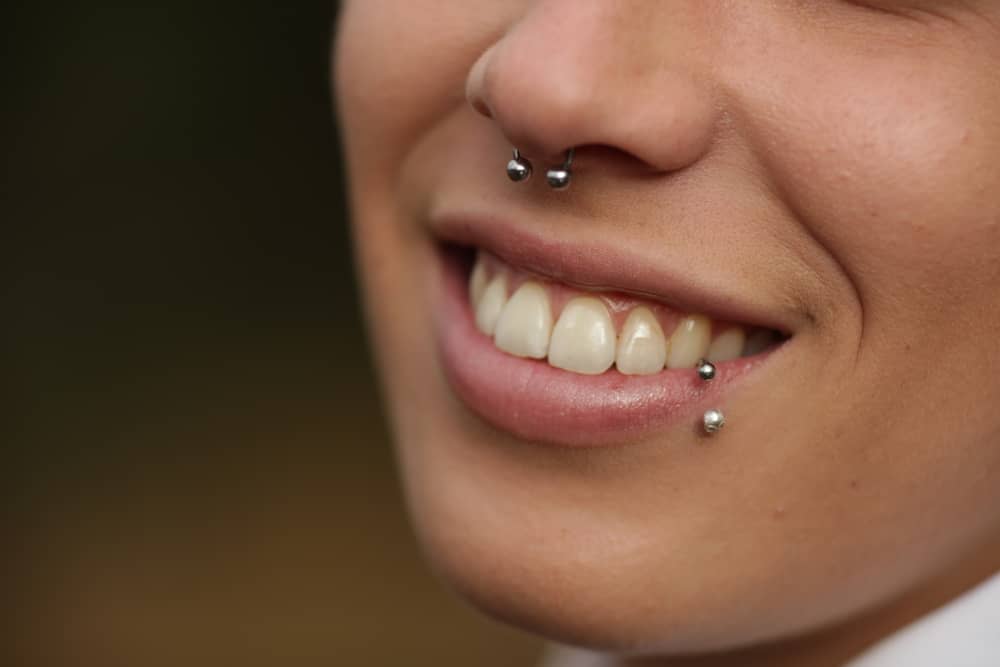
Final Thoughts
Whether you’re an artist looking for a good piercing numbing cream to keep in your parlor or you’re looking for a way to make your own piercing experience more pleasant, It’s important to have up-to-date information about the market for anesthetics and pain relievers. There are many anesthetics on the market today, and there are great options to fit any price and purpose.
